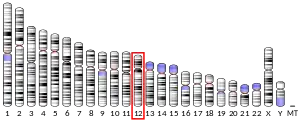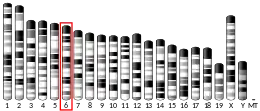Prohibitin-2 is a protein that in humans is encoded by the PHB2 gene.[5][6][7]
Interactions
References
- 1 2 3 GRCh38: Ensembl release 89: ENSG00000215021 - Ensembl, May 2017
- 1 2 3 GRCm38: Ensembl release 89: ENSMUSG00000004264 - Ensembl, May 2017
- ↑ "Human PubMed Reference:". National Center for Biotechnology Information, U.S. National Library of Medicine.
- ↑ "Mouse PubMed Reference:". National Center for Biotechnology Information, U.S. National Library of Medicine.
- ↑ Coates PJ, Nenutil R, McGregor A, Picksley SM, Crouch DH, Hall PA, Wright EG (Apr 2001). "Mammalian prohibitin proteins respond to mitochondrial stress and decrease during cellular senescence". Exp Cell Res. 265 (2): 262–73. doi:10.1006/excr.2001.5166. PMID 11302691.
- ↑ Coates PJ, Jamieson DJ, Smart K, Prescott AR, Hall PA (Oct 1997). "The prohibitin family of mitochondrial proteins regulate replicative lifespan". Curr Biol. 7 (8): 607–10. doi:10.1016/S0960-9822(06)00261-2. PMID 9259555. S2CID 7153605.
- ↑ "Entrez Gene: PHB2 prohibitin 2".
- ↑ Martini, Paolo G V; Katzenellenbogen Benita S (Jun 2003). "Modulation of estrogen receptor activity by selective coregulators". J. Steroid Biochem. Mol. Biol. 85 (2–5): 117–22. doi:10.1016/S0960-0760(03)00207-3. ISSN 0960-0760. PMID 12943695. S2CID 32374864.
Further reading
- Martini PG, Katzenellenbogen BS (2003). "Modulation of estrogen receptor activity by selective coregulators". J. Steroid Biochem. Mol. Biol. 85 (2–5): 117–22. doi:10.1016/S0960-0760(03)00207-3. PMID 12943695. S2CID 32374864.
- Ansari-Lari MA, Muzny DM, Lu J, et al. (1996). "A gene-rich cluster between the CD4 and triosephosphate isomerase genes at human chromosome 12p13". Genome Res. 6 (4): 314–26. doi:10.1101/gr.6.4.314. PMID 8723724.
- Ansari-Lari MA, Shen Y, Muzny DM, et al. (1997). "Large-scale sequencing in human chromosome 12p13: experimental and computational gene structure determination". Genome Res. 7 (3): 268–80. doi:10.1101/gr.7.3.268. PMID 9074930.
- Montano MM, Ekena K, Delage-Mourroux R, et al. (1999). "An estrogen receptor-selective coregulator that potentiates the effectiveness of antiestrogens and represses the activity of estrogens". Proc. Natl. Acad. Sci. U.S.A. 96 (12): 6947–52. Bibcode:1999PNAS...96.6947M. doi:10.1073/pnas.96.12.6947. PMC 22022. PMID 10359819.
- Hu RM, Han ZG, Song HD, et al. (2000). "Gene expression profiling in the human hypothalamus-pituitary-adrenal axis and full-length cDNA cloning". Proc. Natl. Acad. Sci. U.S.A. 97 (17): 9543–8. Bibcode:2000PNAS...97.9543H. doi:10.1073/pnas.160270997. PMC 16901. PMID 10931946.
- Martini PG, Delage-Mourroux R, Kraichely DM, Katzenellenbogen BS (2000). "Prothymosin Alpha Selectively Enhances Estrogen Receptor Transcriptional Activity by Interacting with a Repressor of Estrogen Receptor Activity". Mol. Cell. Biol. 20 (17): 6224–32. doi:10.1128/MCB.20.17.6224-6232.2000. PMC 86097. PMID 10938099.
- Strausberg RL, Feingold EA, Grouse LH, et al. (2003). "Generation and initial analysis of more than 15,000 full-length human and mouse cDNA sequences". Proc. Natl. Acad. Sci. U.S.A. 99 (26): 16899–903. Bibcode:2002PNAS...9916899M. doi:10.1073/pnas.242603899. PMC 139241. PMID 12477932.
- Bouwmeester T, Bauch A, Ruffner H, et al. (2004). "A physical and functional map of the human TNF-alpha/NF-kappa B signal transduction pathway". Nat. Cell Biol. 6 (2): 97–105. doi:10.1038/ncb1086. PMID 14743216. S2CID 11683986.
- Kurtev V, Margueron R, Kroboth K, et al. (2004). "Transcriptional regulation by the repressor of estrogen receptor activity via recruitment of histone deacetylases". J. Biol. Chem. 279 (23): 24834–43. doi:10.1074/jbc.M312300200. PMID 15140878.
- Lehner B, Sanderson CM (2004). "A Protein Interaction Framework for Human mRNA Degradation". Genome Res. 14 (7): 1315–23. doi:10.1101/gr.2122004. PMC 442147. PMID 15231747.
- Gerhard DS, Wagner L, Feingold EA, et al. (2004). "The Status, Quality, and Expansion of the NIH Full-Length cDNA Project: The Mammalian Gene Collection (MGC)". Genome Res. 14 (10B): 2121–7. doi:10.1101/gr.2596504. PMC 528928. PMID 15489334.
- Rush J, Moritz A, Lee KA, et al. (2005). "Immunoaffinity profiling of tyrosine phosphorylation in cancer cells". Nat. Biotechnol. 23 (1): 94–101. doi:10.1038/nbt1046. PMID 15592455. S2CID 7200157.
- Rual JF, Venkatesan K, Hao T, et al. (2005). "Towards a proteome-scale map of the human protein-protein interaction network". Nature. 437 (7062): 1173–8. Bibcode:2005Natur.437.1173R. doi:10.1038/nature04209. PMID 16189514. S2CID 4427026.
- Scherer SE, Muzny DM, Buhay CJ, et al. (2006). "The finished DNA sequence of human chromosome 12". Nature. 440 (7082): 346–51. Bibcode:2006Natur.440..346S. doi:10.1038/nature04569. PMID 16541075.
- Kasashima K, Ohta E, Kagawa Y, Endo H (2007). "Mitochondrial functions and estrogen receptor-dependent nuclear translocation of pleiotropic human prohibitin 2". J. Biol. Chem. 281 (47): 36401–10. doi:10.1074/jbc.M605260200. PMID 17008324.
- Ewing RM, Chu P, Elisma F, et al. (2007). "Large-scale mapping of human protein–protein interactions by mass spectrometry". Mol. Syst. Biol. 3 (1): 89. doi:10.1038/msb4100134. PMC 1847948. PMID 17353931.
- Takata H, Matsunaga S, Morimoto A, et al. (2007). "PHB2 protects sister-chromatid cohesion in mitosis". Curr. Biol. 17 (15): 1356–61. doi:10.1016/j.cub.2007.07.009. PMID 17656096. S2CID 18987683.
This article is issued from Wikipedia. The text is licensed under Creative Commons - Attribution - Sharealike. Additional terms may apply for the media files.



